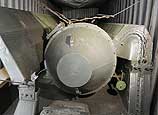
WASHINGTON, July 17 (Xinhua) -- All gold on the Earth might have come from extreme crashes between dense dead stars, U.S. researchers reported Wednesday.
Gold is not only rare on our planet, but also rare in the universe. Unlike elements like carbon or iron, it cannot be created within a star. Instead, new research suggests it might be born in a more cataclysmic event like the collision of two neutron stars, the dead cores of stars that previously exploded as supernovae.
"We estimate that the amount of gold produced and ejected during the merger of the two neutron stars may be as large as 10 Moon masses -- quite a lot of bling!" said lead author Edo Berger of the Harvard-Smithsonian Center for Astrophysics, in a statement.
The team based its findings on observations of a flash of high- energy gamma rays, or gamma ray burst (GRB), known as GRB 130603B, which was detected by U.S. NASA's Swift satellite in June.
The burst is believed to be the result of a collision between two neutron stars, and in this case, GRB 130603B, at a distance of 3.9 billion light-years from Earth, lasted for less than two- tenths of a second, it said.
Although the gamma rays disappeared quickly, GRB 130603B displayed a slowly fading glow dominated by infrared light. Its brightness and behavior didn't match a typical "afterglow," which is created when a high-speed jet of particles slams into the surrounding environment, the team said in a report to be published in the Astrophysical Journal Letters.
It said the glow behaved like it came from "exotic radioactive elements," which can be generated by the neutron-rich material ejected by colliding neutron stars.
"We've been looking for a 'smoking gun' to link a short gamma- ray burst with a neutron star collision. The radioactive glow from GRB 130603B may be that smoking gun," said Wen-fai Fong, a graduate student at the Harvard-Smithsonian Center for Astrophysics and a co-author of the paper.
The team calculated that about one-hundredth of a solar mass of material was ejected by the gamma-ray burst, some of which was gold.
By combining the estimated gold produced by a single short GRB with the number of such explosions that have occurred over the age of the universe, the team found that all the gold in the cosmos might have come from gamma-ray bursts.
"To paraphrase Carl Sagan, we are all star stuff, and our jewelry is colliding-star stuff," Berger said.
















 China’s weekly story
China’s weekly story
(2013.7.5-7.12)


![]()
